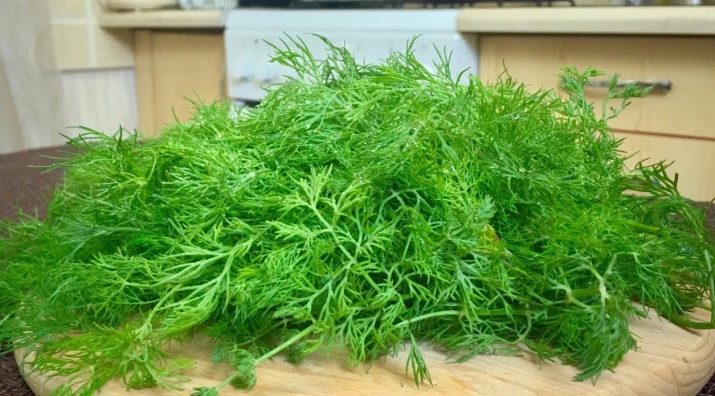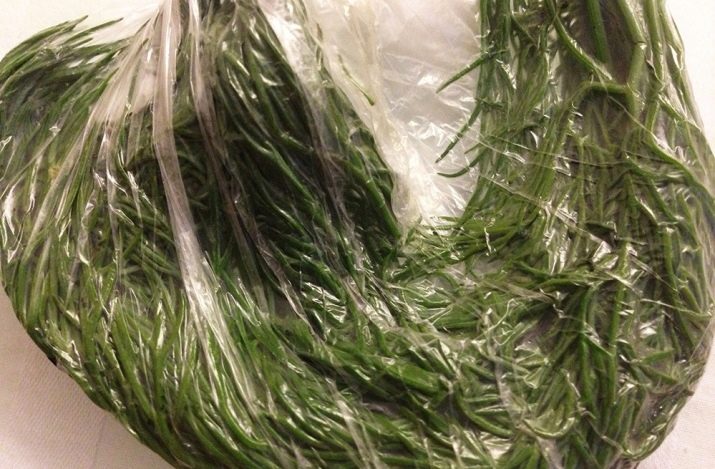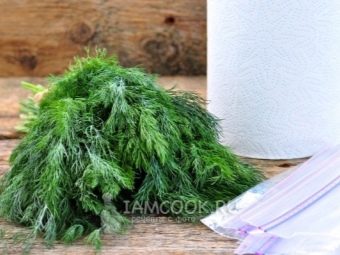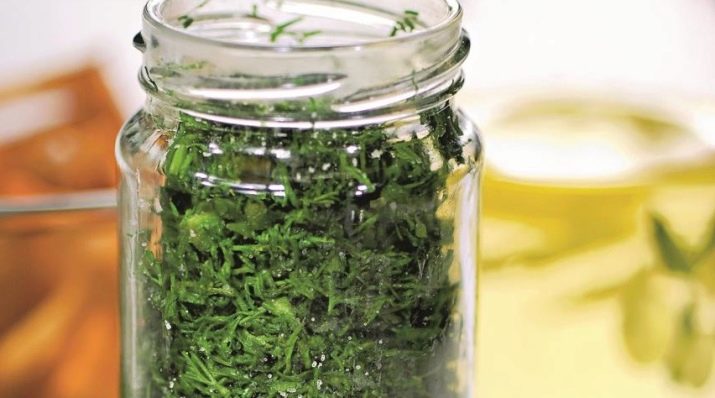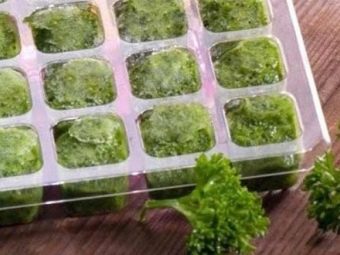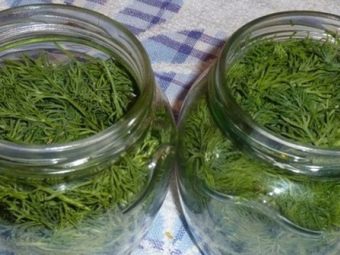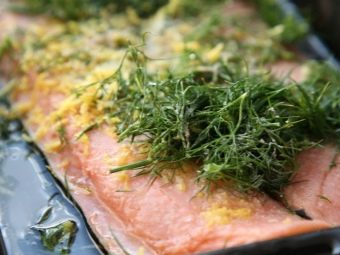Dill for the winter: recipes blanks and cooking secrets without drying and freezing
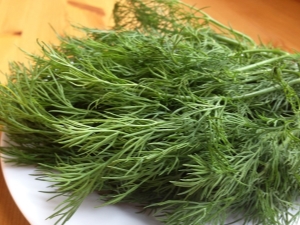
It is easy to decorate a winter dining table in a modern way in modern conditions. However, only properly harvested greens will help to preserve bright colors and flavor. The article presents the current recipes blanks and secrets of cooking herbs without drying and freezing.
The benefits and benefits of blanks
Prepared for the winter fruits of summer will help make the diet rich in taste and color. With the departure of the season of active growth of vegetables, fruits and other vegetation, there is an acute need for them. Shops and farms are ready to help in this case. However, this option will not please demanding hostesses.
If a person is used to seeing products from his garden on the table, then only the cellar with its own blanks can save the situation. The taste of the product grown on its beds never compares with store counterparts.
At home, it is not difficult to pickle, freeze or preserve dill for the future, given the recommendations of specialists. For this fit even the stems.
The benefits and benefits of their own blanks do not end there. To them it makes sense to add a few points.
Issue price
The cost of fresh produce in winter is often prohibitive. This is due to the cost of the growing process. To produce vegetables or green plants in winter, it is not enough just to throw a couple of grains into the ground. It is necessary to create appropriate conditions that will imitate the summer.
The nutritional value
Farm products are distinguished by purity and utility. In small gardens, people tend to carry out cheap and affordable procedures for the treatment of vegetation. In the case of industrial cultivation in winter, the plants receive a large number of growth and maturation accelerators.
Vegetation and fruits, which in winter delight the eye of the buyer in the store, contain much less vitamins and useful elements.
Taste qualities
The difference in the characteristics of products of own and industrial production is particularly noticeable in the summer. Amateur farmers often complain about the lack of smell and taste of vegetables from the counter.
In aggregate, all this leads people to the idea of the need to harvest the products of summer for the winter. They are happy to grow everything in the garden. Vegetables and fruits after ripening collect and give them the desired appearance. Does not do in this matter without green seasonings. This is because they give your favorite dishes a complete look.
Ways to save
Farm products blanks will bring tangible benefits and benefits only if they are executed correctly. There are many actual recipes for conservation.
When choosing, one should be guided by two main criteria:
- required shelf life;
- storage conditions and use.
If you store the harvested greens is planned no longer than one month, then you can do with a refrigerator. In this case, all its qualities will be saved as fully as possible. Cold and lack of light will help slow down wilting. Spice retains juiciness and moisture.
There are several ways to store green spices. They differ in auxiliary means.
No extra effort
The easiest way is to send future spices to the vegetable compartment in the fridge right after harvesting. Pack it better in paper and wrap film.
If it is not washed, the shelf life can exceed ten days.
Package in the fridge
Dill after harvesting cleaned from old leaves. After that, it is washed under running water. On the spread out paper laid out to dry. After half an hour, everything is disassembled into bundles. They are also laid out in packages and tightly closed.
Stored billet in the refrigerator.Instead of bags, you can use a plastic container with a tight lid.
Water container
Plants are required to be decomposed freely into a container. There should also be poured water at room temperature. It is important to ensure that the leaves do not look out from under the water. All this should be sent to the refrigerator for six hours.
Over time, the water should be drained and the green part should be shaken and put in a dry container with a lid. It should also be stored in the refrigerator.
Paper towels
In order to increase the shelf life of the product is better not to wash before harvesting. It should be divided into bundles of five branches and immediately wrapped in two layers of paper towels with roots. You can wrap all this cling film or put in a bag. Keep the workpiece better in the refrigerator.
Bank and package
In this case, sprigs of food supplements should be put in a container with water. On their free part, you must wear a thin bag and secure it with an elastic band. The entire structure should be stored in the refrigerator.
Sterilized can
Fresh dill bundles laid out in sterilized and dried vessels. All this closes the lid. On condition of tightness, the vegetation will be stored for several months without freezing.
In any of these cases, the plants will sooner or later begin to lose their attractiveness. Return them to the old beauty can be through a contrast dipping. First, the green is required to dip in hot, and then - in cold water. It is important to remember that the method works only in the first days after cutting.
Freezing and drying is very popular among housewives. These methods allow you to store seasoning for a long time. In addition, they are very simple. However, they are not able to convey the range of taste emotions, which are filled with modern dishes.
For longer storage of aroma, it is better to use pickling or pickling. Salting helps preserve color and flavor. You can use the result throughout the upcoming year. Additive is perfect for hot dishes. However, do not forget about excess salinity.
Salting and pickling imply conservation. Here it should be remembered that this process partially destroys the usefulness of the product. However, this significantly increases the shelf life.
To make dill blanks through salting and pickling, it is not enough just to rinse and dry. It is important to adhere to the recipe. All of them are complex at first glance. However, any hostess will cope with any of them.
Best recipes
Regardless of the recipe, which is taken as a basis, there are two stages of preparing greens:
- washing the spices with water at room temperature;
- Drying after washing on a towel.
But it is also worth remembering two important rules of the preparatory stage:
- do not spread the seasoning in the sun;
- required to protect it from wind and insects.
Salting in banks (layers)
This recipe is simple. For it you need to prepare the container with screw caps, salt and dill. The last element must be searched and deleted thick and old branches. Be sure to rinse it.
After weighing the main ingredient, it is necessary to determine the amount of salt. It is necessary to proceed from the proportion: one and a half kilograms of dill - four hundred grams of salt.
In the prepared container, you first need to pour salt. The thickness of the layer is about five millimeters. Top should put a green layer in one centimeter. Layers of grass and salt should be alternated to the top of the can. It is important that the top layer is salt.
The filled jar needs to be closed and shaken. This will help the salt to be distributed correctly over the dill. At the end of the container should be tightly closed the lid, put it in storage in a cool place.
Optionally, you can add lemon juice.
Pickle with marinade
The additive is prepared in the usual way. Be sure to grind. Marinade is preparing for it. For one kilogram of plants you will need:
- one and a half glasses of water;
- three tablespoons of six percent vinegar;
- thirty grams of salt;
- fifty grams of butter.
Pepper, laurel leaf is added to taste. The solution is added to greens and sterilized. Be sure to close the lid well.
This type of blank is best left in the basement. It is well suited as a supplement to any kind of dishes. It can be used independently.
Salting in banks (dry)
The first step is to prepare the container. Well suited glass screw containers of five hundred grams. They must be sterilized.
Dill is important to carefully sort and leave the young, fresh areas. All this is important to rinse in a colander and dry on a towel. Chopped seasoning must be mixed with salt in the proportion of two hundred grams of salt per five hundred grams of greens. In the process of mixing all this is better to knead.
It is important to mix the mixture in the dishes tightly. The resulting juice can be drained. After filling all you need to close the lid and send in the refrigerator.
Marinated Dill
There are people who do not like salty food. In this case, they should pay attention to the dill in the marinade. The solution preserves the product, retains its color and taste. And also it gives spice to the dish.
There are many recipes for marinating plants. For dill, you can try the most popular option.
This variant of preparation has been known for a long time.
It will require:
- half a kilogram of dill items;
- a quarter cup of lemon acid;
- a pair of garlic cloves;
- three leaves of laurel;
- ten grams of sugar;
- as much salt;
- a glass and a fifth of purified vegetable oil.
Garlic should be peeled and cut into several pieces. To it you can add all that remains. All this should be put into a large frying pan and brought to a boil, and then cooled.
Container is required to disinfect. In her put the herb element and pour hot marinade. The jars with the mixture must be put in a deep bowl of boiling water. The process of such sterilization should take about seven minutes. After completion of the container is required to pull out and roll up.
Blanks must be left alone to cool. After that, they are required to be transferred to cool storage.
Oil seasoning
Oil well covers all greens, prevents the development of bacteria and mold. This allows you to save it for a long time.
For the conservation of dill using vegetable oil will not need a lot of ingredients. It is enough to cook vegetation, olive oil.
Clean shredded twigs should be distributed in glass cans. After that, there should also pour oil, so that it completely covers the plant elements. Bubbles should not be. Capacity with the composition must be tightly closed. Keep spice better in the dark and cool.
This food supplement is perfect complement potato dishes, pasta. The recipe can be supplemented with lemon zest, pepper and other spiciness.
There is another version of the recipe. In it, freshly cut vegetation is chopped, rammed into a container. Oil is poured into it. Banks are well closed and stored in the refrigerator. After two weeks, seasoning is ready for use.
Infusion of dill plants with oil
This option of "oil preservation" will help to give the dish a delicate aroma of summer. For it should be prepared dried branches and spice seeds, sunflower oil.
Portions of spice and oil are placed under the cover for a week and a half. All this is insisted in the dark. After the time the resulting composition can be used.
Pesto (sauce)
Separately want to talk about the sauce. Cooked with a recipe sauce well complements fish dishes, pasta, cream soups.
Ingredients:
- two hundred grams of freshly harvested greens;
- three garlic cloves;
- five grams of salt;
- a quarter cup of cedar nuts;
- a quarter of a teaspoon of ground pepper;
- a teaspoon of grated lemon peel;
- twenty five grams of olive oil.
Ingredients mix and chop with a blender.After that, you need to decompose everything in small jars, sterilize and close.
Pine nuts, if necessary, can be replaced by any familiar analogue.
Useful tips
If you do everything according to the recipe, you can save the dill until the new crop. However, mold can form in pickling. To prevent it is important to add ground pepper.
If unpleasant mold fungi were found in salting last year, you will have to change the recipe a little.
Ingredients: one kilogram of the main element must be poured two hundred fifty grams of salt and one teaspoon of pepper. And also should stock up on two tablespoons of vegetable oil.
Preparation of green supplement occurs as usual. The selected part must be crushed. In a separate container, all this must be mixed with salt and grind. After the appearance of the juice there also add ground pepper.
The mixture is compacted tightly on pre-washed and dried containers. Top poured vegetable oil. Banks are closed with lids and sent to the refrigerator.
When choosing the processing of future spices during the preparation for the winter it is worth remembering that dried and pickled dill is well suited for salads.
Frozen option will help in baking. Dill greens in any form can be put in soups and side dishes, meat and fish, sauces.
The salted version has a specific taste. It is better to add it to dishes at the end of heat treatment.
Marinated variant of the preparation can be supplemented with leaves of currant, horseradish and cherry.
Making spice is easy. However, many people are lazy to do it. Quite often, they do not even put in food its dried counterpart. Do not neglect this.
The composition of dill plants are very important substances. These are beta carotene, B vitamins, potassium, magnesium, iron, phosphorus, copper, calcium, zinc and tocopherol.
Combined in the spice petals, these substances increase immunity. They also protect against the action of bacteria and stop inflammatory processes. Vegetation of this kind relieves and soothes.
The following video shows 3 ways of harvesting dill for the winter.

